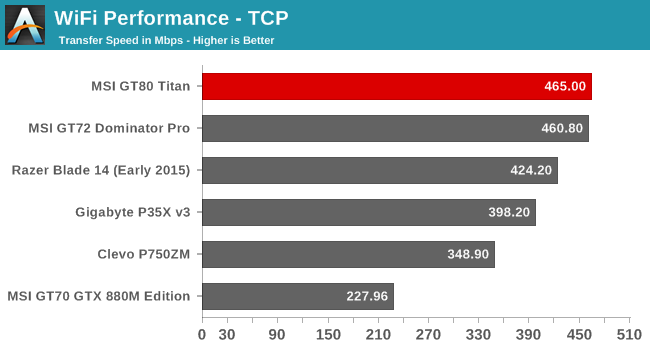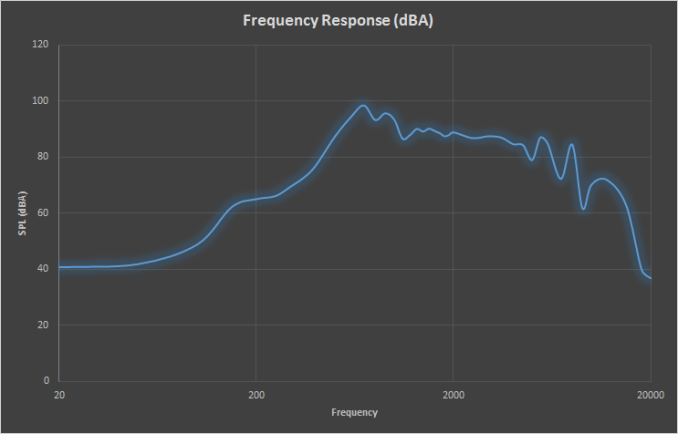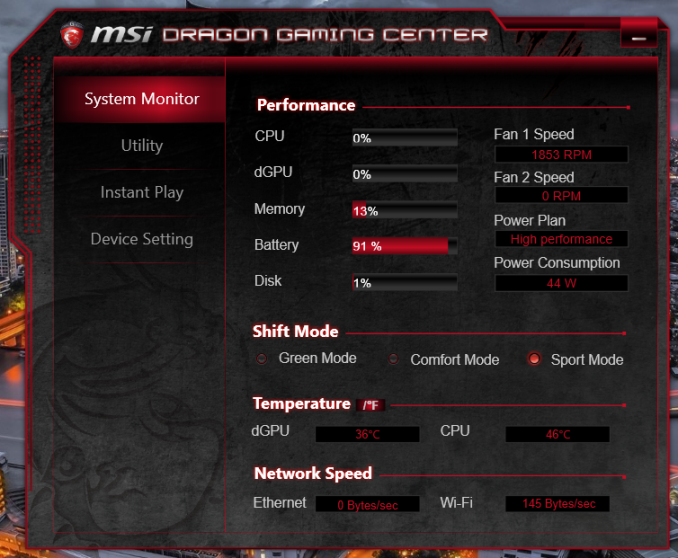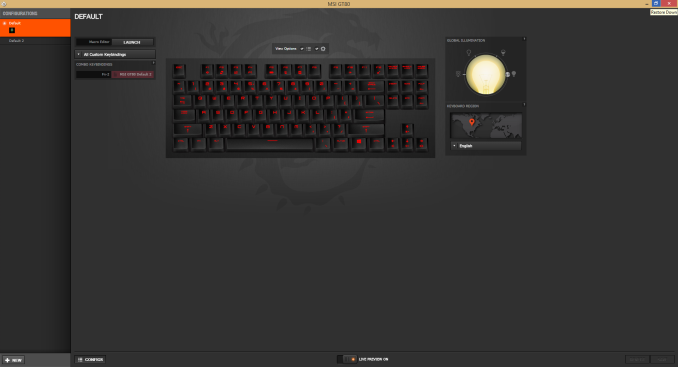The MSI GT80 Titan Review: The Broadwell Gaming Laptop Your Desktop Envies
by Brett Howse on June 26, 2015 8:00 AM ESTWireless
For networking, MSI has turned to Rivet Network’s Killer branded solutions, with the GT80 Titan featuring a Killer Wireless-AC 1525 adapter for wireless connections, and the Killer e2200 Gigabit Ethernet controller to handle the wired connections. It also supports the Killer Double Shot Pro which lets the networking load balance between the wireless and wired connections. This theoretically allows for 1.867 Gbps of usable network bandwidth, but in the average home where both would be hooked to the same router it is going to have limited appeal.
This adapter has worked well for me, and I did not have any issues with connection or wake from sleep.

The Killer networking card performs quite well. It is not quite as quick as Broadcom’s 802.11ac solution but it is fairly close. There is also an array of Killer software utilities to set up and monitor your network adapters.
The software may be overkill for some, but since this device is targeted at the enthusiast crowd you can be sure there will be people who like to check out their stats and see how much downloading they have done.
Audio and Noise
MSI includes Dynaudio Premium Speakers with a Subwoofer on the GT80. The power output is not listed, however the setup gets very loud. Listening to some music I was able to measure 93 dB(A) from this setup which makes it one of the loudest I have measured. Let’s take a look at the frequency response from the setup.
The subwoofer does help out a bit, with the GT80 Titan having reasonable response at the low end of the curve but it is not amazing. However once you get past the low end, the frequency response was pretty flat over most of the range which is a good result. Idealy the ultimate response would be a flat line but that would take some pretty amazing speakers. I would have liked to see a bit better out of the Titan due to its size, but still it is a good result. You really can’t beat a good set of headphones though.
Noise and Cooling
When a device ships with a 330 watt A/C adapter, it is going to need some serious cooling capabilities to move all of that heat, and MSI has included just that. There are several fan profiles you can select from to choose how much you want them to ramp up. At idle, the fans are running but are only a couple of dB over the noise floor. In my not very quiet room, I measured around 40 dB at idle with a room that is around 36 dB with the laptop off. It’s not silent but it’s not overpowering. If you start to work the laptop, it will slowly ramp up the fans to 43-44 dB. If you are gaming, it can easily hit 48-53 dB. MSI has also included a fan switch which sets the fans to maximum speed, and this can move a lot of air. The noise is quite loud though at 63 dB. When I was doing gaming benchmarks, the maximum fan speed was good for 5-10 more frames per second, which is a nice boost however when you are already well over 100 frames per second it is likely fine to leave the fans on auto and save your hearing.
On the cooling side, at idle the GPUs are around 34°C, and the CPU sits around 44°C. Power draw, according to MSI’s utility, is around 40-50 watts at idle. To test gaming performance, I looped the Tomb Raider benchmark on Ultimate for an hour or so. GPU and CPU temperatures were only 75°C and the fans were running about 50%, and this is with the GPU running at 85% usage. Power draw was 180-200 watts. If you prefer noise to temperatures though, just hit the max fan button. At maximum cooling, the GPU temperature drops to an amazing 57°C and the CPU drops to just 61°C in the same test.
Software
Normally when I talk about software on a laptop, it is about the extra bloat that always finds its way on there. MSI is not perfect here, with some Norton trialware and the like, but overall the trialware is pretty light. There are a lot of utilities installed which should appeal to the target enthusiast market though so let’s go over some of them.
I have already discussed the True Color utility on the display page, and that is a wonderful utility mostly because when you set the display to sRGB it actually is a very accurate sRGB profile.
But there is a lot more than that. Likely the most useful is the Dragon Gaming Center which allows you to monitor the CPU and GPU load and temperature, fan speed, disk, and network utilization. It is a nice one-stop shop. It even shows the active power consumption (FYI at idle it states it is around 40-50 watts) and you can also change a few gaming settings here as well such as disabling the Windows key. It is a nice utility and it fits in well with both the theme of the laptop as well as the target demographics.
MSI also has a System Control Manager which is a full-screen overlay that lets you set common settings. You can enable or disable Bluetooth for example, or shut off the display.
For audio, MSI leverages software from Nahimic. There are the standard audio effects available to be turned on or off, such as reverb, simulated surround sound, as well as frequency leveling and bass boost. On the microphone side, you can set up the levels and such. It is a nice utility and the layout is very easy to get around.
Since the Titan comes with a Steelseries keyboard, there is also some software for that to customize the keyboard and adjust the backlighting.























103 Comments
View All Comments
Notmyusualid - Saturday, June 27, 2015 - link
Funny, they didn't look anything alike to me. Try this: http://www.specsavers.co.uk/eye-health/eye-testGigaplex - Friday, June 26, 2015 - link
How difficult is it to source compatible MXM modules these days? I've seen laptops with upgradeable graphics in the past, but no compatible upgrades were released.Flunk - Friday, June 26, 2015 - link
Everyone is obsessed with packaging now and you can get a smaller laptop if you forgo the MXM slot, you save a bit of cash too. Since almost no one needs the modules, few places sell them and they're absurdly expensive.The only place I know for sure that sells them is Eurocom: http://www.eurocom.com/ec/vgas(1)ec
hyno111 - Friday, June 26, 2015 - link
Not very hard, but only if your laptop supports it, most laptops with upgradeable gpu only supports +1 gen gpu. And expect insane prices.extide - Friday, June 26, 2015 - link
You CAN get them, especially on Ebay and a few other sites but they are EXTREMELY expensive!Meaker10 - Friday, June 26, 2015 - link
MSI will sell them to you through your reseller who can do the upgrade for you and keep your warranty. This is a special service for GT72 and GT80 users.Notmyusualid - Saturday, June 27, 2015 - link
Source? Fleabay. I've bought a few over the years. And when 980M GTX price falls, I'll be buying a couple of those.Physical / electrical compatability? Here: http://www.mxm-upgrade.com/Tech_13.html
chizow - Friday, June 26, 2015 - link
Wow that's a lot of GPU perf and a fast Broadwell chip too. Too bad there's no G-Sync, I'm not in the market for a "gaming" laptop, but I couldn't imagine spending that much on one today without G-Sync support.ingwe - Friday, June 26, 2015 - link
Good point. If I was going to put out the money for this, I would definitely want G-Sync.Xenonite - Saturday, June 27, 2015 - link
I would also consider a G-Sync display to be mandatory at this point for any computer aimed at providing good gaming performance, however with a 60Hz display I do not feel like it's inclusion would have had much of an impact on the smoothness of gaming on the integrated monitor (I have owned a Asus ROG Swift 144Hz G-Sync display for about a year now and I could not see much of a benefit of G-Sync, even with Nvidia's own pendulum demo. 33ms is just too long to display a single frame for; the motion is going to be unnatural and jumpy even if the frames are presented in perfect sync with the monitor).I would still have wanted the review to test the display's response time and input lag, but seeing as it is capped at 60Hz AND is not a TN panel, I suspect that MSI would not have been too happy with the numbers had they been posted.
That said, when it is used as a true desktop replacement, with an external monitor, the GT80 would probably be capable of producing a very nice gaming experience, as long as the mobile SLI implementation does not intorduce unwanted frame time variances.